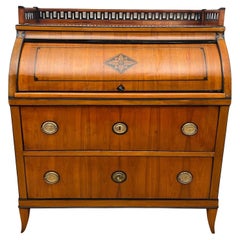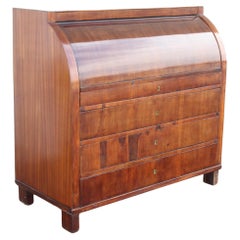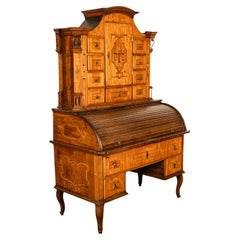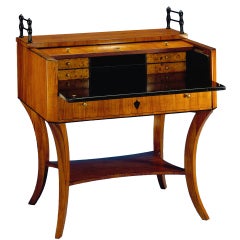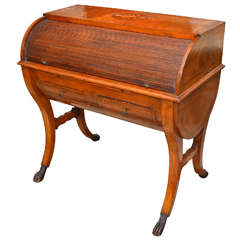Biedermeier Roll Top Desk
Antique 1820s German Biedermeier Secretaires
Brass
Antique Mid-19th Century German Biedermeier Secretaires
Wood
Antique 1820s Austrian Baroque Secretaires
Elm, Fruitwood, Ebony
Recent Sales
Antique 19th Century German Biedermeier Desks and Writing Tables
Cherry, Ebony, Maple, Pine
Antique 19th Century Italian Biedermeier Desks
Wood, Cherry
Antique 19th Century German Desks and Writing Tables
Antique 19th Century French Biedermeier Desks and Writing Tables
Walnut
Antique 19th Century Austrian Biedermeier Desks
Baize, Maple
Antique 19th Century German Biedermeier Desks and Writing Tables
Wood, Mahogany, Walnut
Antique 1860s Austrian Biedermeier Desks
Maple
Antique 19th Century German Biedermeier Secretaires
Wood, Walnut
Antique 1870s Unknown Biedermeier Desks and Writing Tables
Pine
People Also Browsed
Vintage 1970s Italian Post-Modern Sectional Sofas
Metal
Antique Mid-19th Century Austrian Biedermeier Benches
Maple
Antique Early 1900s Austrian Jugendstil Chandeliers and Pendants
Brass
Antique Mid-19th Century Austrian Biedermeier Serving Bowls
Wood
Antique Mid-19th Century English Decorative Art
Brass
Antique Late 18th Century French Buffets
Oak
Early 20th Century French Louis XVI Sideboards
Marble
20th Century French Hollywood Regency Planters and Jardinieres
Iron, Wrought Iron, Gold Leaf
Antique Early 19th Century German Biedermeier Apothecary Cabinets
Iron
Antique Late 19th Century English Regency Revival Vitrines
Mahogany, Satin, Glass, Ebony, Satinwood
Antique 17th Century Italian Renaissance Cabinets
Brass, Bronze
Antique Late 18th Century English George III Desks and Writing Tables
Wood
Antique Late 19th Century Italian Rococo Revival Desks and Writing Tables
Wood, Paint
20th Century Bookcases
Oak
Antique Early 19th Century French Louis XV Sideboards
Wrought Iron
Antique Mid-19th Century English Desks
Rosewood
A Close Look at Biedermeier Furniture
The authentic Biedermeier furniture on 1stDibs is representative of the first modern European decorative style not dictated by the tastes of the aristocracy. Following the Napoleonic wars, a growing, wealthy urban middle class in the German-speaking states of Central Europe began to demand rights and privileges once granted only to nobles. To avoid trouble, the upwardly striving confined their political discussions to one another’s homes. And so the salon was born.
Cabinetmakers in cities such as Vienna, Berlin and Mainz began to offer goods that reflected the tastes and needs of the new class. The makers of Biedermeier chairs, tables and other furniture used little or no gilding, silver hardware or other lavish ornament. Ebonized trims are common on Biedermeier cabinetry, and neoclassical elements — lyre-shaped chair splats, carved scrollwork, table supports shaped like Greek columns. But the strongest aesthetic statement came from the wood — richly-grained, honey-colored, often book-matched veneers of walnut and fruitwood.
There are two iconic Biedermeier furniture forms, both made to outfit rooms designed for conversation. One is the sofa, deeply upholstered with a strong, architectural wooden frame. The second is the circular pedestal table, which stood at the center of the room, offering a surface on which to place coffee and cake services; or to roll out a map, or sketch out ideas on paper.
“Biedermeier” was originally a derogatory term — it derives from the pen names of two German magazine writers who mocked bourgeois manners. Looking at the elegant and refined antique, new and vintage Biedermeier furniture offered on 1stDibs, that is now an amusing irony.
Finding the Right Case Pieces And Storage Cabinets for You
Of all the vintage storage cabinets and antique case pieces that have become popular in modern interiors over the years, dressers, credenzas and cabinets have long been home staples, perfect for routine storage or protection of personal items.
In the mid-19th century, cabinetmakers would mimic styles originating in the Louis XIV, Louis XV and Louis XVI eras for their dressers, bookshelves and other structures, and, later, simpler, streamlined wood designs allowed these “case pieces” or “case goods” — any furnishing that is unupholstered and has some semblance of a storage component — to blend into the background of any interior.
Mid-century modern furniture enthusiasts will cite the tall modular wall units crafted in teak and other sought-after woods of the era by the likes of George Nelson, Poul Cadovius and Finn Juhl. For these highly customizable furnishings, designers of the day delivered an alternative to big, heavy bookcases by considering the use of space — and, in particular, walls — in new and innovative ways. Mid-century modern credenzas, which, long and low, evolved from tables that were built as early as the 14th century in Italy, typically have no legs or very short legs and have grown in popularity as an alluring storage option over time.
Although the name immediately invokes images of clothing, dressers were initially created in Europe for a much different purpose. This furnishing was initially a flat-surfaced, low-profile side table equipped with a few drawers — a common fixture used to dress and prepare meats in English kitchens throughout the Tudor period. The drawers served as perfect utensil storage. It wasn’t until the design made its way to North America that it became enlarged and equipped with enough space to hold clothing and cosmetics. The very history of case pieces is a testament to their versatility and well-earned place in any room.
In the spirit of positioning your case goods center stage, decluttering can now be design-minded.
A contemporary case piece with open shelving and painted wood details can prove functional as a storage unit as easily as it can a room divider. Alternatively, apothecary cabinets are charming case goods similar in size to early dressers or commodes but with uniquely sized shelving and (often numerous) drawers.
Whether you’re seeking a playful sideboard that features colored glass and metal details, an antique Italian hand-carved storage cabinet or a glass-door vitrine to store and show off your collectibles, there are options for you on 1stDibs.
- What is a roll top desk?1 Answer1stDibs ExpertApril 5, 2022A roll top desk is a piece of furniture that has a wooden cover that can be pulled down when the desk is not in use. Shop a collection of roll top furniture from some of the world’s top sellers on 1stDibs.
- 1stDibs ExpertApril 5, 2022Roll-top desks are originally from the late 18th century in the Georgian era of England. By the middle of the Victorian era, they were found in most offices and produced on a large scale. Shop a range of antique roll-top desks on 1stDibs.
- 1stDibs ExpertApril 5, 2022A roll top desk kept small essentials and paperwork organized. The roll top design was ideal for business people to secure their desks at the end of the day without filing away their work. Browse a variety of roll top desks on 1stDibs.
- What is a roll top desk called?1 Answer1stDibs ExpertApril 5, 2022Sometimes, roll-top desks are called tambours, sliding roll desks or roll-up desks. However, roll-top is the most commonly used name. The style of desk became popular during the 19th century. You can find a range of roll-top desks on 1stDibs.
- 1stDibs ExpertOctober 12, 2021A roll top desk can be worth anywhere between $3,000 to $6,000, depending on the condition, materials used and time of manufacturing. Roll top desks are expensive, as they are very popular on the antique furniture market and are considered timeless collectibles. Shop a range of antique and vintage roll top desks on 1stDibs.
- 1stDibs ExpertApril 5, 2022A variety of factors can determine the exact age of an antique roll top desk. Some things to look for is the type of wood and craftsmanship used to create the desk. Typically, older desks will be made from heavier wood. You can also check for a maker’s marks to determine the age. When in doubt, work with a certified appraiser to determine the authenticity of your roll top desk. You’ll find a variety of expertly vetted roll top desks on 1stDibs.
- 1stDibs ExpertMarch 22, 2022To tell if a roll-top desk is an antique, look closely at the materials. Real antiques feature hardwoods like cherry, mahogany and black walnut. If you detect the use of engineered woods, the desk is a reproduction. Also, early pieces show off irregular dovetail joints. Joints that appear perfectly uniform indicate that a roll-top desk is a more recent mass-produced piece. On 1stDibs, shop a variety of expertly vetted antique roll-top desks.
